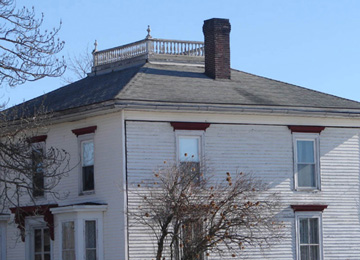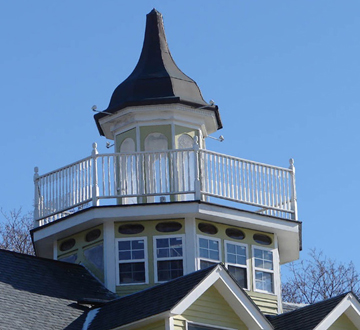Widow’s Walks?

Fine Classic Widow's Walk in Searsport. Industry flourished and people building new homes worked with larger budgets. This provided an avenue for the highly-stylized, ornately-appointed, widow’s walks that make “sea captain’s” homes so special. Photo by Tom Seymour
The faithful and dedicated wife, performing her daily circumambulations on the cold and lonely widow’s walk: The next sail to top the horizon may well carry her husband, gone to sea these many years. But not today. The sun sets, bringing to a close her lonely vigil for this day. Perhaps, though, the much-anticipated vision will appear tomorrow and if not tomorrow, the next day.
Who can deny the romance and nostalgia associated with the legend of the widow’s walk? Unfortunately, the legend has no basis in fact and is, in truth, only a sentiment-laden myth. The actual facts concerning widow’s walks are far more prosaic.
In a day when houses were primarily heated by wood, widow’s walks provided access to the roof, and more important, to the chimney. Consider this. In days past, homeowners kept leather buckets filled with sand, near the hearth. These were to use in the event of a chimney fire. Sometimes the buckets held water, too. In either case, the buckets were taken to the widow’s walk where the contents were poured down the chimney in order to douse the fire.
Anyone who has ever tried to put a ladder to the roof of a two-story (widow’s walks were built primarily on two-story, or taller, structures) building in winter knows that snow and ice make it a formidable, if not nearly impossible, task. Even after setting up and firmly grounding the ladder, climbing such heights in freezing weather presents a real, element of danger. Widow’s walks, accessible from inside the house, provide a safe and efficient solution to this problem.

Early enclosed widow’s Walk were a metal rail around the hatch opening. The rail added some safety and ornamentation. Photo by Tom Seymour
Structures Evolve
In fact, widow’s walks have undergone a lengthy evolution. The first widow’s walks, especially on colonial structures, were nothing more than a hatch, opening to the roof. These had little or no aesthetic appeal and were of an entirely practical nature. Most houses with steeply-pitched, or unusually high roofs were equipped with an access port, or hatch, the forerunner of today’s widow’s walk.
In time, the New England economy strengthened. Industry flourished and people building new homes worked with larger budgets. This provided an avenue for the highly-stylized, ornately-appointed, widow’s walks that make “sea captain’s” homes so special. These structures, cupolas and belvederes, were completely enclosed, but with windows that opened.
A drive through any seaside town on U.S. Route 1 shows numerous instances of these ornate, widow’s walks. Many of these highlight the older structures in that town, a quick way to take a capsulated, historical tour.
Even so, the newer (compared to the simple, hatch) and more elaborate widow’s walks, while stylish and popular, continued to provide practical benefits. First, since fireplaces and wood-burning stoves frequently produce volumes of smoke, widow’s walks were indispensable for providing quick and easy ventilation. Since smoke rises, opening the windows and doors of a widow’s walk provides a direct way for smoke to escape. In fact, since widow’s walks sit atop the structure, opening the windows usually provides at least a token draft.

In the days prior to electric fans or air-conditioning, houses became hot, stuffy and practically uninhabitable in hot, humid weather. Again, opening the widow’s walk to the elements provided much-needed, air circulation. Photo by Tom Seymour
This top-opening feature has considerable value in summer, too. In the days prior to electric fans or air-conditioning, houses became hot, stuffy and practically uninhabitable in hot, humid weather. Again, opening the widow’s walk to the elements provided much-needed, air circulation.
Of course people sometimes took their afternoon tea or evening cocktails in the lofty comfort of their widow’s walks. The views obtained from such locations would surely rate as a compelling one, no matter the reason for visiting.
Sometime in the late 19th century, after the advent of these advanced, stylized, widow’s walks, the legend of the lonely wife, the “mariner’s widow” took form. This romanticized notion, outlined at the beginning of this piece, did much to impart mystique and, in fact, monetary worth to houses that sported widow’s walks. The legend flourished and indeed, persists to this day.
Who, being unfamiliar with the true facts regarding widow’s walks, would not feel a twinge of nostalgia upon visiting a 19th-century widow’s walk, high atop some seaside structure? For sure, widow’s walks help to sell real estate.

Widow’s walks have acquired a new role; they supply outdoor living space. Evenings spent on a deck or patio become even more special when taken on a widow’s walk. Photo by Tom Seymour
Modern Version
With the advent of the 20th century, prices on shorefront property escalated, tightening the market for seaside homes. But even those with large enough purses, didn’t always find what they sought. These people were then compelled to buy or build further back, away from the immediate shoreline.
In that case, what better way to have an ocean view, even if not directly on the ocean, than to get it by way of a widow’s walk? And so the era of the modern widow’s walk began.
Many of these latter-day, widow’s walks, especially those built in the early part of the 20th century, retained the distinctive, ornate style of those fashioned in an earlier day. But in time, the cost for glassed-in structures became fairly prohibitive. Enter the era of wide-open, widow’s walks.
Although ocean views now go for a premium, that doesn’t mean that most people don’t want one. Widow’s walks to the rescue. These have become rather standard on new homes in seaside towns. Nyles Parker, executive director for Penobscot Maritime Museum, says that in many seaside towns, particularly Nantucket, Massachusetts, open, widow’s walks are standard issue on new homes.
Modern widow’s walks began with just a simple, iron railing and in time, that became a wooden railing. These differ in style, height and so on, but the concept of a flat, four-sided platform and wrap-around railing has become quite standard.
People today have little need of roof access in winter and electric, air-conditioning keeps their houses cool in summer. Accordingly, widow’s walks have acquired a new role; they supply outdoor living space. Evenings spent on a deck or patio become even more special when taken on a widow’s walk. Cool and mostly, insect-free, today’s widow’s walks provide the ideal gathering place for modern folk. Luncheons, picnics and more, in the wide-open space high atop a two-story building, become commonplace happenings, thanks to these modern, open-air, widow’s walks.
Finally, amateur astronomers have their own, private observatories in the form of widow’s walks.
Widow’s walks have a venerable history and the true story, while nowhere near as romantic as the folk myth, is of great interest. It provides us with a glimpse into the needs and wants of those who settled these New England shores before us.
